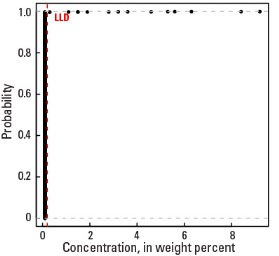
The purpose of these interpretive discussions is to provide a perspective on regional- and national-scale variations in element and mineral distributions in soils and their likely causes. The significant spatial variations shown by most elements and minerals can commonly be attributed to geologic sources in underlying parent materials, but other spatial variations seem clearly related to additional factors such as climate, the age of soils, transported source material, and anthropogenic influences. We attempt to distinguish the influence of these various factors on a regional and national scale. Numerous more local features might similarly be related to these same factors, but these features also have some probability of being an artifact of a random sampling of variable compositions, so that there is some probability of samples with similar compositions occurring in clusters of two or more adjacent sites by chance. Distinguishing such random occurrences from true variability is beyond the scope of the data from which these maps are constructed. Some caution, therefore, is advisable in interpreting the significance of these more local features unless some unique sources or processes can clearly be related to them.
Analcime is a sodium (Na)–rich, hydrated aluminosilicate mineral with a chemical formula of Na(AlSi2O6)•(H2O). Analcime is usually classified in the zeolite group, a somewhat remarkable set of minerals in that their open, channel–like crystal structure permits continuous (and in part reversible) dehydration and exchange. These characteristics allow zeolites to absorb, hold, release, and exchange a wide range of natural and manmade constituents. In soils, analcime commonly is inherited from soil parent materials, typically volcanic rocks or tuffaceous sediments, or less commonly may form directly in saline–affected volcanic or nonvolcanic soils through pedogenic processes. Analcime also may be added to soils through eolian or fluvial deposition.
The distribution of mineral resource deposits with zeolites as a commodity (major or minor) in the United States, extracted from the U.S. Geological Survey (USGS) Mineral Resource Data System (MRDS) website, can be seen by hovering the mouse here. Statistics and information on the worldwide supply of, demand for, and flow of zeolites, including analcime, are available through the U.S. Geological Survey (USGS) National Minerals Information Center (NMIC website).
In our data, analcime is exceedingly rare, present at only 15 of 4,773 sites in the soil C horizon, and in 59 sites in the soil A horizon (see the summary statistics [open in new window]). Because so few samples have analcime concentrations above the 0.2 weight percent (wt. %) lower limit of detection, the spatial distribution of analcime is shown as a proportional symbol map rather than an interpolated and smoothed color surface map.
In the soil C horizon, a cluster of analcime occurrences in eastern Utah and western Colorado is in the Uinta Basin (Fenneman and Johnson, 1946). The Uinta Basin contains basin–floor sediments, dominantly sand, shale, and tuff, derived from surrounding mountains and plateaus. Tuff is the likely soil parent material for analcime, which could have been inherited from parent rock or formed directly in soils from alteration of volcanic glass in lakebed deposits that floor the basin.
At most sites outside the southeastern United States, analcime in the soil A horizon occurs where it is present in the soil C horizon, suggesting similar sources in soil parent materials. Most analcime occurrences in the western United States can be linked to volcanic sources. About 25 occurrences in the southeastern United States do not fit the described characteristics of analcime formation in soils. Zeolites have begun to be used as soil conditioners to improve the physical and chemical properties of some soils. Zeolites also have been incorporated into phosphate rock fertilizers to increase their solubility, and used as a feed supplement for some farm animals. It is speculated that some of the analcime occurrences in areas with no apparent geologic or pedogenic sources are the result of human application of zeolites to soils.
Statistics - 0 TO 5 CM
Statistics - A Horizon
| Number of samples | 4,802 |
| LLD | 0.2 wt. % |
| Number below LLD | 4,743 |
| Minimum | <0.2 wt. % |
| 5 percentile | <0.2 wt. % |
| 25 percentile | <0.2 wt. % |
| 50 percentile | <0.2 wt. % |
| 75 percentile | <0.2 wt. % |
| 95 percentile | <0.2 wt. % |
| Maximum | 9.6 wt. % |
| MAD | |
| Robust CV |
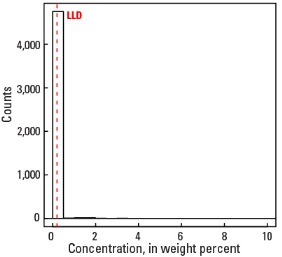
Histogram
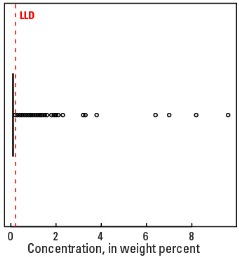
Boxplot
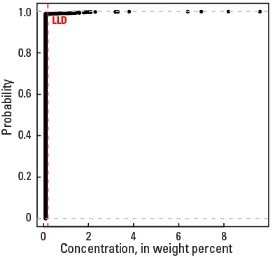
Empirical cumulative distribution function
Statistics - C Horizon
| Number of samples | 4,773 |
| LLD | 0.2 wt. % |
| Number below LLD | 4,758 |
| Minimum | <0.2 wt. % |
| 5 percentile | <0.2 wt. % |
| 25 percentile | <0.2 wt. % |
| 50 percentile | <0.2 wt. % |
| 75 percentile | <0.2 wt. % |
| 95 percentile | <0.2 wt. % |
| Maximum | 9.2 wt. % |
| MAD | |
| Robust CV |
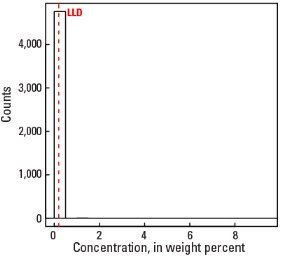
Histogram
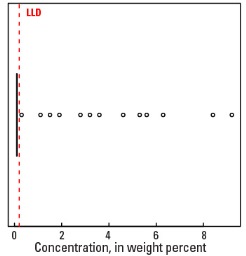
Boxplot
